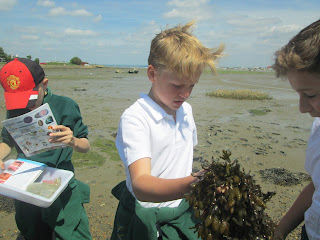 Year 6 kick-started their post-SATs enquiry on Monday with vigour by visiting Milton Locks. At school we had just started to think about habitats both around the world and closer to home, define what 'habitat' means and think about how the flora and fauna adapt to their habitat and environment.
Year 6 kick-started their post-SATs enquiry on Monday with vigour by visiting Milton Locks. At school we had just started to think about habitats both around the world and closer to home, define what 'habitat' means and think about how the flora and fauna adapt to their habitat and environment.
Milton Locks nature reserve information
The education officers, Jess and Derek, from the HIWWT plus Alison, a specialist in entomology (study of insects), and Tim, a specialist in seashore creatures, joined us as well. This made for very complete workshops as so much could be identified. During the morning Mr Wildman also joined us and was able to identify all of the plants we found too.
 The aim of the session was to help the HIWWT with their data collection of flora and fauna on this particular stretch of the coast. Sweep nets and quadrats were used for the collection of insects, and for counting the different species of plants. Sticky strips collected leaf types, and data recording sheets were completed to hand to the HIWWT. Here are just some of the insects we found: assassin beetle, soldier beetle (much to Lottie's delight), leaf hopper, flea beetle, green cricket, parasitic wasp, weevil, crab beetle, jumping spider, zebra spider, pill woodlouse, pollen beetle, mesh web spider, labyrinth spider and a shield beetle Bishop's Mitre. We also found a very strange ladybird which Alison couldn't identify. She took it away with her and emailed back the same day with some exciting news: this was a Water Ladybird with the Latin name of Annisosticta novemdecimpunctata and is a first record for Portsea Island. Alison has submitted
it to the National Ladybird survey. This is proper ground breaking science!
The aim of the session was to help the HIWWT with their data collection of flora and fauna on this particular stretch of the coast. Sweep nets and quadrats were used for the collection of insects, and for counting the different species of plants. Sticky strips collected leaf types, and data recording sheets were completed to hand to the HIWWT. Here are just some of the insects we found: assassin beetle, soldier beetle (much to Lottie's delight), leaf hopper, flea beetle, green cricket, parasitic wasp, weevil, crab beetle, jumping spider, zebra spider, pill woodlouse, pollen beetle, mesh web spider, labyrinth spider and a shield beetle Bishop's Mitre. We also found a very strange ladybird which Alison couldn't identify. She took it away with her and emailed back the same day with some exciting news: this was a Water Ladybird with the Latin name of Annisosticta novemdecimpunctata and is a first record for Portsea Island. Alison has submitted
it to the National Ladybird survey. This is proper ground breaking science!

 On the seashore things got a little more gloopy and we all needed to identify everything we saw from the particles under our feet, the different types of shells and seaweed and the seashore creatures for intertidal data collection. This did prove quite hilarious on occasion as our wellies had a tendency to get stuck in the very wet sand. Tim and Alison proved to be very informative and helped us to observe and identify many creatures we might have overlooked such as hydrobia which are abundant on the sands and are the main food for the sea birds. Spiral wrack was a type of seaweed which again was abundant and Tim explained about the bladders within the wrack, and the seed pods on the ends of each stem. Our wildlife finds included: green shore crabs, ribbon worms, barnacles, American hard back clams, periwinkles, cord grass, spiral wrack, common wrack, eel grass, oyster shells, cuttlefish bladders, gut weed, sand hoppers, five bearded rockling, worm casts, shanny and ragworm.
On the seashore things got a little more gloopy and we all needed to identify everything we saw from the particles under our feet, the different types of shells and seaweed and the seashore creatures for intertidal data collection. This did prove quite hilarious on occasion as our wellies had a tendency to get stuck in the very wet sand. Tim and Alison proved to be very informative and helped us to observe and identify many creatures we might have overlooked such as hydrobia which are abundant on the sands and are the main food for the sea birds. Spiral wrack was a type of seaweed which again was abundant and Tim explained about the bladders within the wrack, and the seed pods on the ends of each stem. Our wildlife finds included: green shore crabs, ribbon worms, barnacles, American hard back clams, periwinkles, cord grass, spiral wrack, common wrack, eel grass, oyster shells, cuttlefish bladders, gut weed, sand hoppers, five bearded rockling, worm casts, shanny and ragworm.All of this data has been taken back to school as well, and will be used in further science and maths lessons.
 |
| Checking out the labyrinth spider |
 |
| Sweeping in a figure of eight |
 |
| I'm sure I can figure what this stuff is |
Looks like it was a great trip! Thank you.
ReplyDelete